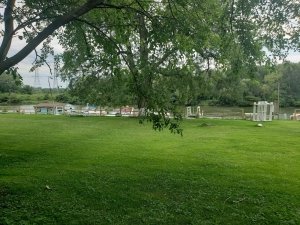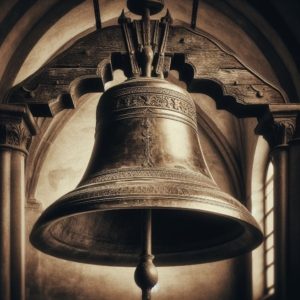 I couldn’t tell you my earliest memory of hearing church bells. I can only tell you, as the son of a preacher, my guess is I’ve heard church bells most of my life. Growing up in a small town in the Midwest, I remember hearing the bells tolling every hour on the hour…and at noon, they would play a short song, er uh, hymn. There is something about playing outside on a warm summer day with bright blue skies and hearing the bells reverberate through town. It’s kind of like baseball and apple pie.
I couldn’t tell you my earliest memory of hearing church bells. I can only tell you, as the son of a preacher, my guess is I’ve heard church bells most of my life. Growing up in a small town in the Midwest, I remember hearing the bells tolling every hour on the hour…and at noon, they would play a short song, er uh, hymn. There is something about playing outside on a warm summer day with bright blue skies and hearing the bells reverberate through town. It’s kind of like baseball and apple pie.
I do remember our annual visits to the Green Lake Conference Center (or just Green Lake as we called it) and the carillon chiming high atop Judson Tower. The peals could be heard across the grounds and from the lake. Trekking the 121 steps to the top of Judson Tower rewarded you with an experience you could feel from the top of your head to the tips of your toes!
When I was in high school, I joined the handbell choir at church. We made some beautiful music if I do say so myself! Our choir became fairly well known in town and we were able to play some high-profile concerts. We made some incredible music…even this old rock and roller has to admit that!
Today, our house reverberates with chimes (bells) from a cuckoo clock, outdoor windchimes, and my grandmother clock (my mother’s clock and she insisted it was NOT a grandfather clock, it was a grandMOTHER clock!
All of this is to tell you why I had to make an extra stop on my most recent trip to Chicago. I had to see the bell. What bell, you ask? Well, let me tell you the story…
Great-Great-Grandfather and The Bell
In 1849, a group of families immigrated from The Netherlands to the south side of Chicago and settled in what is now called Roseland. They called the area High Prairie. These Dutch were devoted members of the Dutch Reformed Church. Soon after their arrival, they founded the First Reformed Church of Roseland.
By 1867, the church had outgrown the house they had been using for services and decided to build their first church building. The frame church at 107th and Michigan Avenue included a wonderful steeple and belfry. Wonderful…but empty.
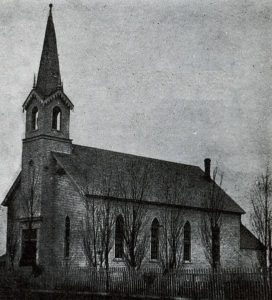
First Reformed Church of Roseland
According to my great-great-aunt Neeltje (Ton) Jansen, daughter of Jan and Aagje Ton (my paternal great-great-grandparents), this bothered her father to no end. As one of the church’s founders, he took it upon himself to raise money for the bell. He donated the first $100 and, in a short time, had the $300 they would need to buy a bell (that’s about $6,500 in today’s dollars). As he collected the money, he gave the money to Aagje, who hid it in an old beaded bag and put it in a drawer for safekeeping.
One night, long after dark, two men knocked on the door asking for directions. When Jan stepped out to point the way, they hit him in the forehead with a slingshot. The two attackers held him down and demanded the money. Bleeding profusely from the wound, he led them to a closet and gave them the money from his trousers. The men knew he had been raising money for the bell and knew there had to be more. They beat him, threw him in the closet, and locked the door. They then proceed to ransack the house. Pour Aagje was confined to her bed, just having given birth two or three days prior, she hid the other children with her and waited. Finally, the men gave up and left. Though they rummaged through the drawer containing the money, they failed to realize the beaded bag contained what they sought.
The very next day, Jan sent the money to Troy, New York, to pay for the newly founded bell.
Our story does not end there.
The Bell Arrives
About a month later, Jan received notice that the bell had arrived in Chicago, he tied his team of oxen to the wagon and rode the 20 miles to the small town along the lake. Possibly to the same port he and his family had arrived at 18 years before.
Three days later, Aagje had not heard from Jan. Distraught, she asked two neighbors to search for him. They found his wagon bogged down in the mud and the bell lying half-buried in the muck near The Eleven Mile House Tavern (92nd and State Street). When they found Jan, he recounted the ordeal of getting stuck in the mud with the heavy bell. His efforts to free the wagon tipped the bell into the mire. Since he was alone, he could not lift the bell back onto the wagon, so he just decided to wait, thinking, “Someone will come looking sooner or later.”
The men rescued the bell and a week later, it was hung in the belfry and called its first worshippers to services.
Visit to The Bell
That was my extra stop…to see the bell. Although a distant cousin had sent me pictures of the bell, I had to see it myself! The bell rang in the belfry the First Reformed Church of Roseland at 107th and Michigan Road until the church built a much larger facility in 1887 just south of the intersections at 107th Street. The bell was later moved to the First Reformed Church of Lansing (Illinois). Today it is on display at Thorn Creek Reformed Church in South Holland, IL…or is it?
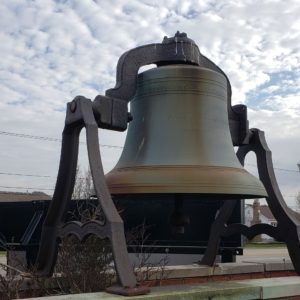
The Bell?
It is now a few weeks after my visit. I knew I wanted to tell the story of the bell. As I wrote, I kept referring back to the pictures I had taken that day, the book about Roseland Down an Indian Trail in 1849 by Marie K. Rowlands, and the story my great-great-aunt had written in 1932. Something was off, but I wasn’t sure what. Then I saw it. The bell at Thorn Creek certainly was forged in Troy, New York as Ms. Rowlands wrote in her book…but the date…the date forged in the bell was 1887…- 1887, not 1867.
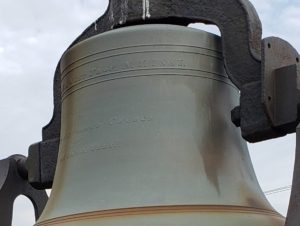
The Date?
So, I began pulling on threads. Those threads led me to research five churches, two foundries, and the history of the Dutch Reformed Church and its various successions and splits.
The First Reformed Church of Roseland did, in fact, build a new larger building in 1887. It seems they must have ordered a new bell for the new facility. The original bell, no longer needed, made its way to the First Reformed Church of Lansing (Illinois). A brother-in-law of Jan’s helped to found the Lansing church. Perhaps that is why the bell was gifted to them?
The Fire
The Lansing church built its first building in 1897. That building burned to the ground in a huge fire in 1945. Newspaper articles from the time describe the steeple (and the belfry) crashing down into the street. An eyewitness, who was ten at the time of the fire, remembers the sound the bell made as it slammed into the roadway.

THE Bell
Photo: Daniel Bovino
The congregation raised money and built a new building on the same spot. Two area historians believe the bell hanging in the belfry of the new building (completed in 1947) is the “Ton Bell.” If it is, it creates another question. Cast into the bell is the name of the bell founder, “A. Fulton.” I cannot find any reference to a bellmaker in Troy, New York, by that name. I can, however, find a renowned bellmaker who had a foundry in Pittsburgh, PA, in the 1800’s. Could the author of the “Indian Trail” book have made a mistake when she wrote, “Ton dispatched the money to Troy, New York with an order for the bell”? That now seems likely.
As for the 1887 bell that is on display in front of the Thorn Creek Reformed Church, how did that bell find its way there? It is clearly cast for the First Reformed Church of Roseland. The answer is less of a mystery than I thought. You see, the Thorn Creek church IS the Roseland church. The church moved to South Holland in the early 1970s. I assume, since there already was a First Reformed Church of South Holland, they named themselves Thorn Creek.
Sometimes when you pull on threads, you confirm the past, sometimes, you reach a dead-end, other times, you gain new insights that rewrite the story. I will keep pulling on threads…
The First Reformed Church of Roseland, IL
- established 1849,
- Original building built 1867
- “Ton” Bell Purchased circa 1868
- New building built 1887
- Second bell (now at Thorn Creek) cast 1887
- moved to South Holland, IL circa 1971
The First Reformed Church of Lansing, IL, established 1861, today called Lansing First Church PCA
- original building built 1897
- “Ton” bell hung in belfry
- Building destroyed by fire 1945
- New building built 1947
- “Ton” bell hung in new belfry
The First Reformed Church of South Holland, IL
- established 1865
- Reorganized 1886
- Site of the Jan and Aagje Ton Memorial Garden 2013
Thorn Creek Reformed Church, South Holland, IL
- First Reformed Church of Roseland relocated to South Holland circa 1971
- Home of the “second” bell from 1887
Lilydale Progressive M.B. Church, Roseland, IL
- Bought the building built in 1887 from the First Reformed Church of Roseland when they moved to South Holland and became Thorn Creek circa 1971

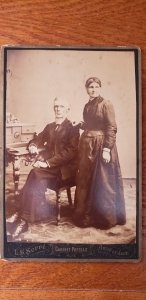

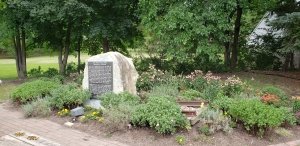 Larry soon arrived, followed shortly thereafter by Duane and June. Let the reunion commence! Larry has been researching the history of the area, the Tons, and the Underground Railroad for years. He has written numerous articles and books on the subject. We stood near the monument while he shared the history with us. He believes between four and five hundred Freedom Seekers passed through this area on their way to Canada. “They had to leave the land of the free, to become free”, he stated.
Larry soon arrived, followed shortly thereafter by Duane and June. Let the reunion commence! Larry has been researching the history of the area, the Tons, and the Underground Railroad for years. He has written numerous articles and books on the subject. We stood near the monument while he shared the history with us. He believes between four and five hundred Freedom Seekers passed through this area on their way to Canada. “They had to leave the land of the free, to become free”, he stated. 